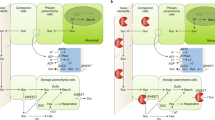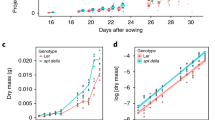Abstract
This paper argues against the ‘bicycle pump’ model of source-sink relationships. It suggests that it is more fruitful to examine the systems which control sink morphogenesis. This argument is illustrated by reference to the cauliflower ‘curd’ (inflorescence). In any given curd the weights of successive ‘florets’ (primary branches) fluctuate above and below their expected values. The fluctuations are not due to restricted vascular pipelines, nor to competitive interactions between neighbouring sinks. They are due to highly systematic fluctuations in the timing of floret initiation, and they entail similar fluctuations in primordium position. The phenomenon can be explained by assuming a control system for cytokinesis in which (i) the position of the cell plate responds to mechanical stress (ii) the degree of responsiveness varies cyclically both in time, and around the apical meristem. It seems from this and other evidence that there are strong local controls of sink development in cauliflower.
Similar content being viewed by others
References
Adler I (1977) The consequences of contact pressure in phyllotaxis. J Theor. Biol. 65: 29–77
Bierhorst DW (1977) On the stem apex, leaf initiation and early leaf ontogeny in filicalean ferns. Amer J Bot 64 (2): 125–152
Bremner PM and Rawson HM (1978) The weights of individual grains of the wheat ear in relation to their growth potential, the supply of assimilate and interaction between grains. Aust J Plant Physiol 5: 61–72
Burström HG (1979) In search of a plant growth paradigm. Amer J Bot 66 (1): 98–104
Cockshull KE and Horridge JS (1980) Further evidence of a relationship between size of the chrysanthemum shoot apex and inflorescence development. Anr Bot 46: 125–127
Cook MG and Evans LT (1978) Effect of relative sink size and distribution of competing sinks on the distribution of photosynthetic assimilates in wheat. Aust J Plant Physiol 5: 495–509
Cooke J and Zeeman EC (1976) A clock and wavefront model for control of the number of repeated structures during animal morphogenesis. J Theor Biol 58: 455–476
Cooke TJ and Padillo DJ Jnr (1980) The control of the orientation of cell division in fern gametophytes. Amer J Bot 67 (9): 1320–1333
Crisp P (1984) Factors causing small curds in cauliflower crops. J agric Sci (in press)
Duncalf WG (1976) The Guiness Book of Plant Facts and Figures. Enfield: Guiness Superlatives Ltd
Edgar E (1961) Fluctuations in mitotic index in the shoot apex of Lonicera nitida. Christchurch: University of Canterbury
Foard DE (1971) The initial protrusion of a leaf primordium can form without concurrent cell divisions. Canad J Bot 49: 1601–3
Erickson RO and Meicenheimer RD (1977) Photoperiod induced change in phyllotaxis in Xanthium. Amer J Bot 64 (8): 981–988
Francis D (1981) A rapid accumulation of cells in G2 in the shoot apex of Silene coeli-rosa during the first days of floral induction. Ann Bot 48: 391–394
French V, Bryant PJ and Bryant SV (1976) Pattern regulation in epimorphic fields. Science 193: 969–981
Gandar DW (1980) The analysis of growth and cell production in root apices. Bot Gaz 141: 131–138
Green PB (1976) Growth and cell pattern formation on an axis critique of concepts, terminology and modes of study. Bot Gaz 137: 187–202
Green PB (1980) Organogenesis: A biophysical view. Annual Reviews of Plant Physiology 31: 51–82
Green PB and Brooks KE (1978) Stem formation from a succulent leaf: Its bearing on theories of axiation. Amer J Bot 65: 13–26
Gregory RA and Romberger JA (1972) The shoot apical ontogeny of the Picea abies seedling. II. Growth rates. Amer J Bot 59: 598–606
Gulline HF and Walker R (1957) The regeneration of severed pea apices; Austral J Bot 5: 129–136
Hardham AR (1982) Regulation of polarity in tissues and organs in the cytoskeleton. In: Lloyd CW, ed. Plant Growth and Development. pp 377–404. London: Academic Press
Hardwick RC, Andrews DJ and Parks LJ (1984) Report of the Physiology Section. Ann Report for 1983 National Vegetable Research Station, Wellesbourne
Heathcote DG and Aston TJ (1970) The physiology of plant nutation. I. Nutation and geotropic response. J Exp Bot 21: 997–1002
Hejnowicz Z (1973) Morphogenetic waves in cambia of trees. Plant Sci Lett 1: 359–366
Hejnowicz Z (1974) Pulsations of domain length as support for the hypothesis of morphogenetic waves in the cambium. Acta Soc Bot Pol 43: 261–271
Hicks GS (1980) Patterns of organ development in plant tissue culture and the problem of organ determination. Bot Rev 461–23
Kauffman SA, Shymko RM and Trabert K (1978) Control of sequential compartment formation in Drosophila. Science 199: 259–270
Larson PR (1980) Interrelations between phyllotaxis, leaf development and the primary, secondary vascular transition in Populus deltoides. Ann Bot 46: 757–769
Lintilhac PM (1974) Differentiation, organogenesis and the tectonics of cell wall orientation. II. Separation of stresses in a two-dimensional model. Amer J Bot 61 (2): 135–140
Lintilhac PM (1974) Differentiation, organogenesis and the tectonics of cell wall orientation. III. Theoretical considerations of cell wall mechanics. Amer J Bot 61 (2): 230–237
Lintilhac PM and Jensen WA (1974) Differentiation, organogenesis and the tectonics of cell wall orientation. I. Preliminary observations on the development of the ovule in cotton. Amer J Bot 61 (2): 129–134
Lintilhac PM and Vesecky TB (1980) Mechanical stress and cell wall orientation in plants. I. Photoelastic derivation of principal stresses. With a discussion of the concept of axillarity and the significance of the ‘Arcuate shell zone’. Amer J Bot 67 (10): 1477–1488
Lintilhac PM and Vesecky TB (1984) Stress-induced alignment of division plane in plant tissues grown in vitro. Nature 307: 363–364
Lyndon RF (1977) Interacting processes in vegetative development and in the transition to flowering at the shoot apex. In: Jennings DH, ed. Integration of Activity in the Higher Plant, pp 221–225 (Symposia of the Society for Experimental Biology 31). Cambridge: Cambridge University Press
Madore BF and Freeman WL (1983) Computer simulations of the Belousov-Zhabotinsky reaction. Science 222: 615–616
Maksymowych R and Erickson RO (1977) Phyllotactic change induced by gibberellic acid in Xanthium shoot apices. Amer J Bot 64: 33–44
Mauldin RD ed. (1982) The Scottish Book: Mathematics from the Scottish Cafe. Boston, Cambridge, Mass.: Birkhäuser
Mauseth JD and Halperin W (1975) Hormonal control of organogenesis in Opuntia polyacantha (cactaceae) Amer J Bot 62: 869–877
McDaniel CN and Hsu FC (1976) Position dependent development of tobacco meristems. Nature 259: 564–5
McHughen A (1980) The regulation of tobacco floral organ initiation. Bot Gaz 141: 389–395
Meicenheimer RD (1979) Relationships between shoot growth and changing phyllotaxy of Ranunculus. Amer J Bot 66 (5): 557–569
Meicenheimer RD (1982) Change in Epilobium phyllotaxy during reproductive transition. Amer J Bot 69:1108–1111
Meicenheimer RD and Larson PR (1983) Empirical models for xylogenesis in Populus deltoides. Ann Bot 51:491–502
Miller JH (1980) Orientation of the plane of cell division in fern gametophytes: the roles of cell shape and stress. Amer J Bot 67(4):534–542
Mitchison GJ (1977) Phyllotaxis and the Fibonacci series. Science 196:270–275
Murray BJ, Mauk C and Nooden LD (1982) Restricted vascular pipelines (and orthostichies) in plants. Whats New in Plant Physiology 13:33–35
Nicolis G and Prigogine I (1977) Self-organization in non-equilibrium systems. New York: Wiley. 491 pages
Niklas KJ and Mauseth JD (1980) Simulations of cell dimensions in shoot apical meristems: Implications concerning zonate apices. Amer J Bot 67(5):715–732
Orr AR (1981) A quantitative study of cellular events in the shoot apical meristem of Brassica campestris (Cruciferae) during transition from vegetative to reproductive condition. Amer J Bot 68:17–23
Rain M (1973) Two unusual methods for debugging system software. Software Practice and Experience 4(1):61–63
Ridley JN (1982) Computer simulation of contact pressure in capitula. J Theor Biol 95:1–11
Roberts DW (1978) The origin of Fibonacci phyllotaxis: An analysis of Adler's contact pressure model and mitchison's expanding apex model. J Theor Biol 74:217–233
Sadik S (1962) Morphology of the cauliflower curd. Amer J Bot 49:290–297
Schoute JC (1913) Beiträge zur Blattstellungslehre. Ric Trav Bot Neerl 10:153–200
Shabde M and Murashige TM (1977) Hormonal requirements of excised Dianthus caryophyllus L. shoot apical meristem in vitro. Amer J Bot 64(4):443–448
Sibatini A (1981) The polar coordinate model for pattern regulation in epimorphic fields: A critical reappraisal. J theor Biol 93:433–489
Silk WK and Erickson RO (1978) Kinematics of hypocotyl curvation. Amer J Bot 65:310–319
Snow M and Snow R (1962) A theory of the regulation of phyllotaxis based on Lupinus albus. Phil Trans R Soc Lond Ser B 244:483–513
Tanimoto E and Masuda Y (1971) Role of the epidermis in auxin-induced elongation of light grown pea stem segments. Plant and Cell Physiology 12:663–673
Tennakone K, Dayatilaka RKD and Aryantne S (1982) Right-left symmetry in phyllotaxy and imbrication of flowers of Hibiscus furcanas. Ann Bot 50:397–400
Thornley JHM and Cockshull KE (1980) A catastrophe model for the switch from vegetative to reproductive growth in the shoot apex. Ann Bot 46:333–341
Trewavas A (1981) How do plant growth substances work? Plant Cell and Environment 4:203–228
Trewavas A (1982) Possible control points in plant development. In: Smith H and Grierson D, ed. The Molecular Biology of Plant Development, pp 7–27. Blackwell
Van Iterson G (1907) Mathematische und mikroskopischie-anatomische Studien über Blattstellungen. Jena Fischer
Varnell RJ and Vasil IK (1978) Experimental studies of the shoot apical meristem of seed plants. I. Morphological and cytochemical effects of IAA applied to the exposed meristem of Lupinus albus. Amer J Bot 65:40–46
Varnell RJ and Vasil IK (1978) Experimental studies of the shoot apical meristem of seed plants. II. Morphological and cytochemical effects of kinetin applied to the exposed meristem of Pinus elliottii. Amer J Bot 65 (1):47–49
Veen AH and Lindenmayer A (1977) Diffusion mechanism for phyllotaxis: Theoretical physico-chemical and computer study. Plant Physiol 60:127–139
Wardlaw CW (1949) Experimental and analytical studies of Pteridophytes. XIV. Leaf formation and phyllotaxis in Dryopteris aristata Druce. Ann of Bot 13:163–197
Whingwiri EE, Kno J and Stern WR (1981) The vascular system in the rachis of a wheat ear. Ann Bot 48:189–201
Winfree AT (1980) The Geometry of Biological Time. New York: Springer, 530 pages
Wolpert L (1981) Positional information and pattern formation. Phil Trans R Soc Lond B 295:441–450
Yeung EC, Aitken J, Biondi S and Thorpe TA (1981) Shoot histogenesis in cotyledon explants of radiata pine. Bot Gaz 142:494–501
Author information
Authors and Affiliations
Rights and permissions
About this article
Cite this article
Hardwick, R.C. Sink development, phyllotaxy, and dry matter distribution in a large inflorescence. Plant Growth Regul 2, 393–405 (1984). https://doi.org/10.1007/BF00027298
Issue Date:
DOI: https://doi.org/10.1007/BF00027298




